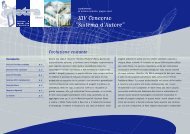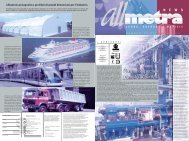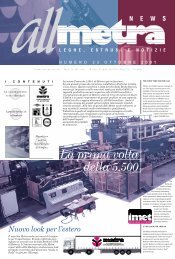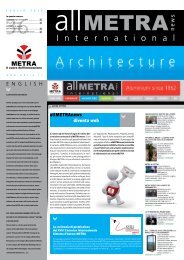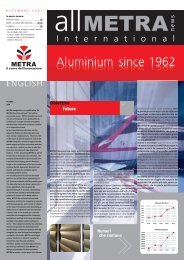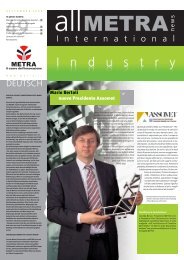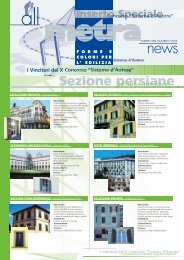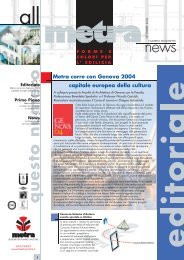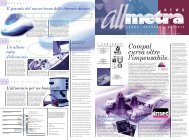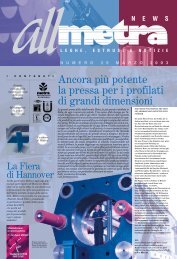2 3 4 Al via lo stabilimento IMET Fiere in Europa e in Asia - Metra SpA
2 3 4 Al via lo stabilimento IMET Fiere in Europa e in Asia - Metra SpA
2 3 4 Al via lo stabilimento IMET Fiere in Europa e in Asia - Metra SpA
Create successful ePaper yourself
Turn your PDF publications into a flip-book with our unique Google optimized e-Paper software.
Terza parte<br />
Un metal<strong>lo</strong><br />
prezioso<br />
S. MIERZINSKI “DIE FABRIKATION DES ALUMINIUMS UND DER ALCAL<strong>IMET</strong>ALLE“ A. HARTBLEN, 1885<br />
ALUMINIUM ALLOYS<br />
<strong>Al</strong>um<strong>in</strong>ium will form al<strong>lo</strong>ys with many other<br />
metals without difficulty. When alum<strong>in</strong>ium is<br />
added to z<strong>in</strong>c, t<strong>in</strong>, gold or silver, it acquires new<br />
properties, becom<strong>in</strong>g harder and g<strong>lo</strong>ssier depend<strong>in</strong>g<br />
on the percentage conta<strong>in</strong>ed <strong>in</strong> the al<strong>lo</strong>y.<br />
The many compounds that can be created with<br />
alum<strong>in</strong>ium are a clear demonstration of<br />
the versatility of this metal.<br />
The process of amalgamation of<br />
alum<strong>in</strong>ium with mercury takes<br />
place very quickly, and causes<br />
the alum<strong>in</strong>ium to <strong>lo</strong>se its lustre.<br />
<strong>Al</strong>um<strong>in</strong>ium is not suitable for<br />
mak<strong>in</strong>g al<strong>lo</strong>ys with lead (the<br />
two metals rema<strong>in</strong> separate),<br />
however it is particularly<br />
suitable for<br />
al<strong>lo</strong>y<strong>in</strong>g with iron, <strong>in</strong><br />
which case it becomes<br />
covered with a layer similar<br />
to t<strong>in</strong>.<br />
The addition of alum<strong>in</strong>ium is particularly useful<br />
<strong>in</strong> the production of cast iron, mak<strong>in</strong>g it harder<br />
and also giv<strong>in</strong>g it a sh<strong>in</strong>y, silvery appearance.<br />
The compound made up of alum<strong>in</strong>ium and z<strong>in</strong>c is<br />
also extremely easy to make, and the result<strong>in</strong>g<br />
product has excellent hardness and ductility<br />
Si chiude con questa terza puntata il percorso di <strong>Al</strong>l <strong>Metra</strong> News attraverso la storia dell'allum<strong>in</strong>io <strong>in</strong><br />
compagnia del volume del Dottor Stanislaus Mierz<strong>in</strong>ski. Il più giovane dei metalli ha <strong>in</strong>iziato ad essere<br />
utilizzato grazie all'<strong>in</strong>gegno e alla fantasia di uom<strong>in</strong>i <strong>in</strong>traprendenti, che hanno dedicato le <strong>lo</strong>ro energie<br />
al<strong>lo</strong> studio e alla ricerca, ma soprattutto hanno creduto nelle sue qualità. Abbiamo forse sorriso leggendo<br />
di procedimenti e lavorazioni che assomigliavano più a formule "magiche" che "scientifiche", ma se<br />
oggi con l'allum<strong>in</strong>io riusciamo a realizzare <strong>in</strong>numerevoli prodotti è stato proprio grazie a quei tentativi<br />
"orig<strong>in</strong>ali".<br />
Le leghe <strong>in</strong> allum<strong>in</strong>io<br />
L'allum<strong>in</strong>io si lega senza difficoltà a molti altri metalli.<br />
Solitamente, questo processo è accompagnato da un notevole sviluppo di ca<strong>lo</strong>re. Le leghe, generalmente,<br />
risultano estremamente omogenee e di facile lavorazione e la durezza della lega è direttamente proporzionale<br />
al contenuto di allum<strong>in</strong>io. Tutta<strong>via</strong>, quando si supera una determ<strong>in</strong>ata percentuale di allum<strong>in</strong>io, il prodotto<br />
diventa fragile, soprattutto se mescolato all'oro e al rame. Quando<br />
l'allum<strong>in</strong>io viene aggiunto al<strong>lo</strong> z<strong>in</strong>co, al<strong>lo</strong> stagno, all'oro o<br />
all’argento, assume nuove proprietà diventando più duro e più<br />
lucente <strong>in</strong> base alla percentuale presente. I<br />
numerosi composti che possono essere creati con<br />
l’allum<strong>in</strong>io sono una chiara dimostrazione della versatilità<br />
di questo metal<strong>lo</strong>. Il processo di amalgama dell’allum<strong>in</strong>io<br />
e del mercurio avviene molto rapidamente e<br />
fa perdere lucentezza all’allum<strong>in</strong>io. Chr. Tissier, Joule e<br />
Cailletet hanno cercato di <strong>in</strong>dividuare il procedimento più<br />
idoneo e ognuno di <strong>lo</strong>ro ha apportato una serie di significative<br />
variazioni. L’allum<strong>in</strong>io non è adatto alla lega con il<br />
piombo (i due metalli restano separati), ma si presta particolarmente<br />
alla lega con il ferro che fa sì che si ricopra di<br />
uno strato simile al<strong>lo</strong> stagno. L'aggiunta di allum<strong>in</strong>io<br />
risulta particolarmente utile nella produzione<br />
della ghisa, alla quale conferisce una maggiore<br />
durezza oltre che un aspetto lucido-argenteo. Anche<br />
il composto allum<strong>in</strong>io/z<strong>in</strong>co è estremamente facile da<br />
ottenere con un risultato di ottima durezza, duttilità<br />
e lucentezza. In lega con <strong>lo</strong> stagno e con il nichelio,<br />
<strong>in</strong>vece, non si deve<br />
superare il 7% pena la separazione dei due metalli. La lega più riuscita è sicuramente<br />
quella tra allum<strong>in</strong>io e argento, che consente la massima elasticità e nel<br />
contempo anche una durezza che non ha niente da <strong>in</strong>vidiare a quella delle monete<br />
d'argento. Questa lega presenta un aspetto lucido-argenteo, è molto leggera,<br />
non è magnetica ed è facile da lavorare. E’ <strong>in</strong>oltre particolarmente apprezzata<br />
nell'oro<strong>lo</strong>geria e <strong>in</strong> altri campi nei quali queste proprietà sono <strong>in</strong>dispensabili.<br />
Per mantenere la sua elasticità, l'allum<strong>in</strong>io<br />
<strong>in</strong> lega con l'oro non deve superare<br />
il 10% <strong>in</strong> tito<strong>lo</strong> aureo. Questa lega è<br />
di facile fuc<strong>in</strong>atura, ma quando la<br />
splendida co<strong>lo</strong>razione dell’oro svanisce,<br />
non può più essere lucidato.<br />
characteristics and of lustre.<br />
In al<strong>lo</strong>ys with t<strong>in</strong> and with nickel, on the other<br />
hand, the percentage must not exceed 7%,<br />
otherwise the two metals will separate.<br />
The most successful al<strong>lo</strong>y is undoubtedly the<br />
al<strong>lo</strong>y made of alum<strong>in</strong>ium and silver, which provides<br />
maximum elasticity and at the same time<br />
a hardness that is comparable with that of silver<br />
co<strong>in</strong>s.<br />
If alum<strong>in</strong>ium is to reta<strong>in</strong> its elasticity <strong>in</strong> al<strong>lo</strong>ys<br />
with gold, the gold content must not exceed 10%.<br />
<strong>Al</strong>l <strong>Metra</strong> News<br />
Leghe, estrusi e notizie<br />
Stampe non Periodiche<br />
Spedizione <strong>in</strong> Abbonamento Postale<br />
Milano<br />
Stampa Grafiche Somalia<br />
Coord<strong>in</strong>amento editoriale<br />
e art direction<br />
Partners <strong>in</strong> Bus<strong>in</strong>ess Communications





